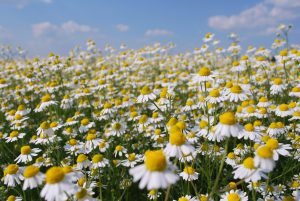Chamomile, a versatile medicinal herb renowned for its calming properties, has been cultivated in Egypt for centuries. The country’s favorable climate, fertile soil, and rich agricultural history make it an ideal location for chamomile cultivation.

Historical Background:
Chamomile has been a staple in Egyptian culture and traditional medicine since ancient times. The herb’s documented use dates back to the time of the Pharaohs, where it was revered for its therapeutic qualities. The legacy of chamomile as a medicinal herb has endured through the ages, with its cultivation becoming an integral part of Egyptian agriculture.
Climatic and Soil Conditions:
Egypt’s diverse climate, characterized by warm temperatures and abundant sunlight, provides an optimal environment for chamomile cultivation. The herb thrives in well-drained, sandy loam soils with a slightly acidic to neutral pH. These conditions are prevalent in regions such as the Nile Delta and Upper Egypt, making them prime locations for chamomile cultivation.
Cultivation Practices:
Chamomile cultivation in Egypt typically involves two main species: German chamomile (Matricaria chamomilla) and Roman chamomile (Chamaemelum nobile). Farmers plant chamomile seeds in the fall or early spring, and the plants begin to flower in late spring or early summer.
The cultivation process involves careful attention to irrigation, as chamomile is sensitive to water stress. Organic farming methods are often preferred to maintain the herb’s purity and meet the growing global demand for organic chamomile products.
Harvesting is a crucial step, usually done when the flowers are in full bloom. The flowers are handpicked to ensure the delicate blooms remain intact, preserving the quality of the chamomile.
Future Prospects:
As global interest in natural remedies and herbal products continues to rise, the demand for chamomile is expected to grow. Egyptian farmers and entrepreneurs have an opportunity to capitalize on this trend by expanding cultivation and exploring innovative ways to add value to chamomile products.
The sustainable cultivation of chamomile aligns with modern agricultural practices, and certifications such as organic and fair trade can further enhance the marketability of Egyptian chamomile. Collaborations between farmers, researchers, and the government can support ongoing efforts to improve cultivation techniques, ensuring the continued success of the chamomile industry in Egypt.

Conclusion:
Chamomile cultivation in Egypt is deeply rooted in the country’s history and culture. The favorable climate and soil conditions, coupled with traditional knowledge and modern farming practices, make Egypt a key player in the global chamomile market. As the demand for natural remedies and herbal products grows, chamomile cultivation in Egypt is poised to thrive, contributing to the nation’s economic prosperity and maintaining its status as a major player in the international herbal market.
